SSC4606: Environmental Law and Governance for Flood Risk Management
VerifiedAdded on 2023/04/20
|16
|3990
|461
Report
AI Summary
This report explores the critical intersection of environmental law and governance in the context of flood risk management. It highlights the problem context, including the environmental consequences of flooding such as damage to crops, livestock, and ecosystems. It also addresses issues like sedimentation and riverbank erosion, which exacerbate the impacts of floods. The report proposes general actions and principles for effective flood management, including flood response techniques like zoning, flood mitigation dams, and levees, as well as property modification techniques such as land filling, flood proofing, and house raising. It emphasizes the importance of strategic environmental assessment (SEA) and environmental impact assessment (EIA) in policy-making and planning for flood-prone areas. Desklib provides access to similar reports and solved assignments for students.
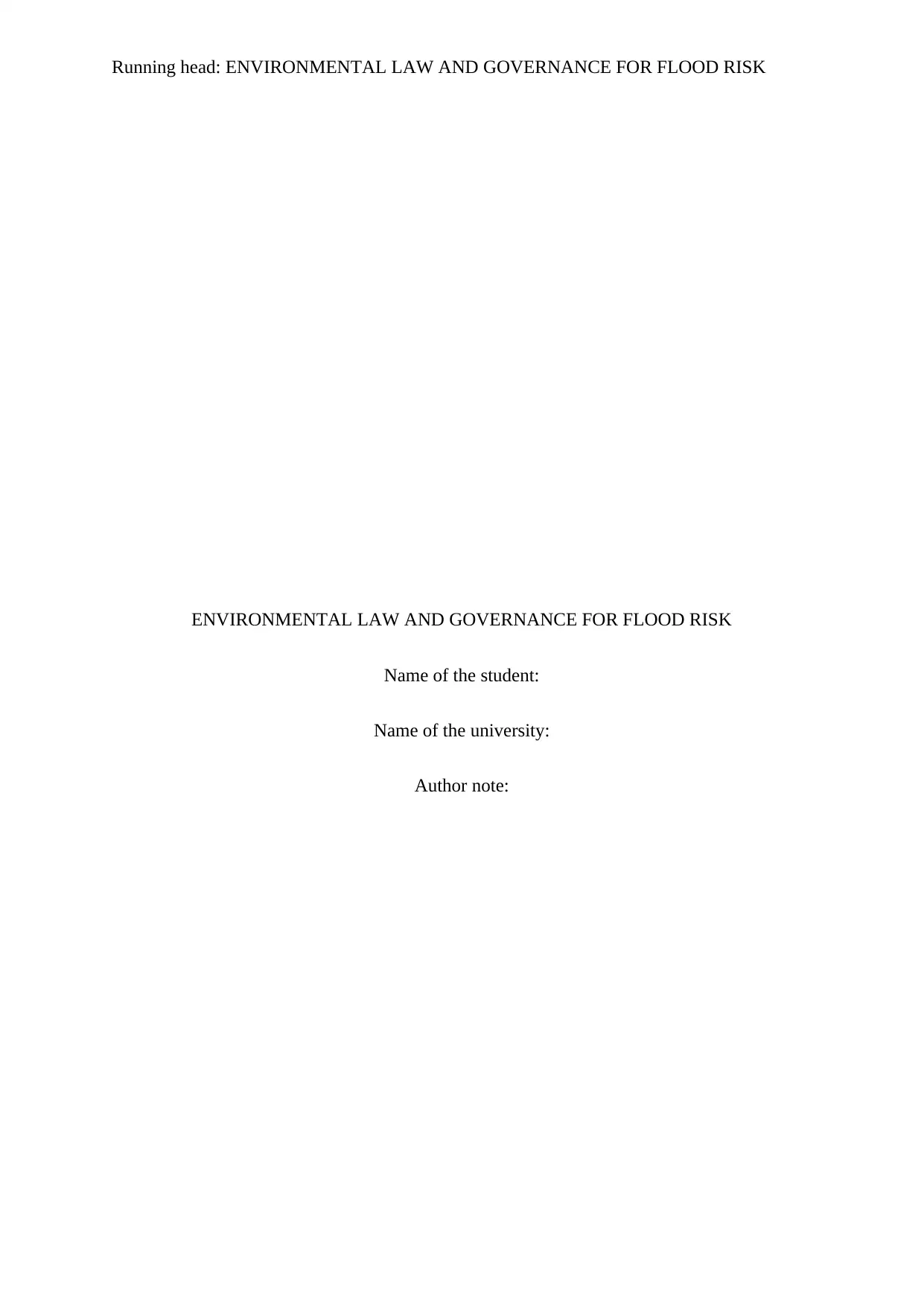
Running head: ENVIRONMENTAL LAW AND GOVERNANCE FOR FLOOD RISK
ENVIRONMENTAL LAW AND GOVERNANCE FOR FLOOD RISK
Name of the student:
Name of the university:
Author note:
ENVIRONMENTAL LAW AND GOVERNANCE FOR FLOOD RISK
Name of the student:
Name of the university:
Author note:
Paraphrase This Document
Need a fresh take? Get an instant paraphrase of this document with our AI Paraphraser
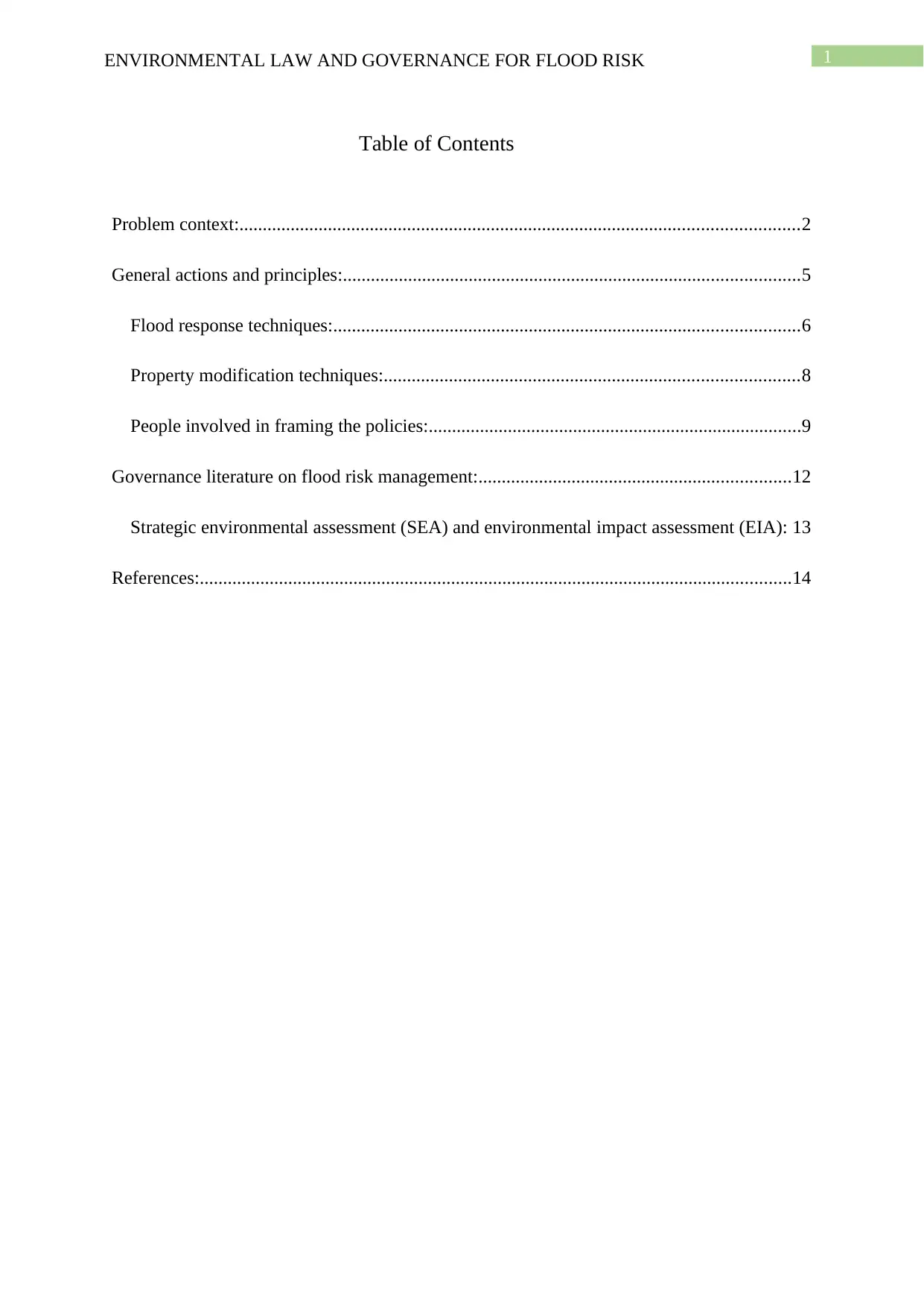
1ENVIRONMENTAL LAW AND GOVERNANCE FOR FLOOD RISK
Table of Contents
Problem context:........................................................................................................................2
General actions and principles:..................................................................................................5
Flood response techniques:....................................................................................................6
Property modification techniques:.........................................................................................8
People involved in framing the policies:................................................................................9
Governance literature on flood risk management:...................................................................12
Strategic environmental assessment (SEA) and environmental impact assessment (EIA): 13
References:...............................................................................................................................14
Table of Contents
Problem context:........................................................................................................................2
General actions and principles:..................................................................................................5
Flood response techniques:....................................................................................................6
Property modification techniques:.........................................................................................8
People involved in framing the policies:................................................................................9
Governance literature on flood risk management:...................................................................12
Strategic environmental assessment (SEA) and environmental impact assessment (EIA): 13
References:...............................................................................................................................14
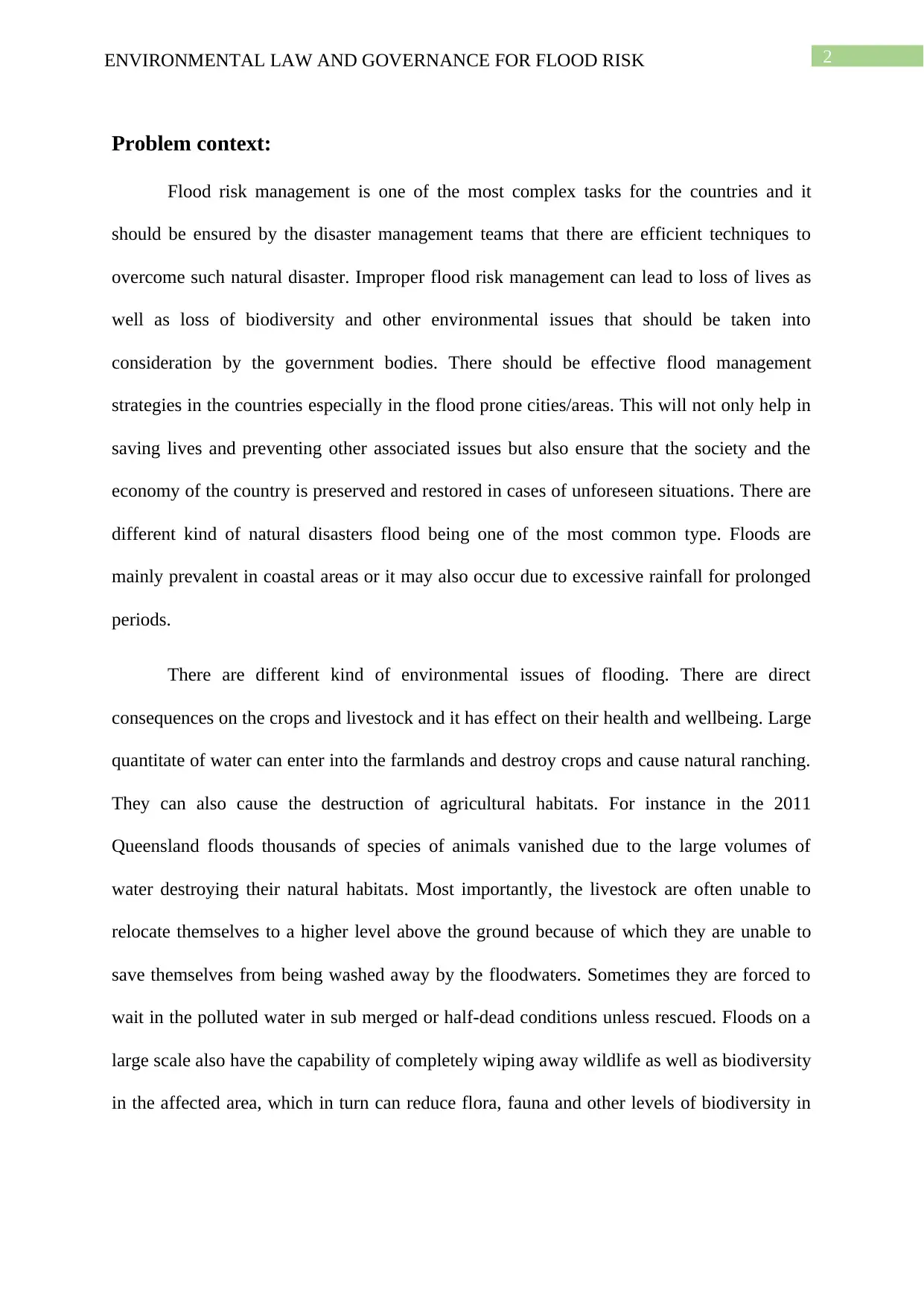
2ENVIRONMENTAL LAW AND GOVERNANCE FOR FLOOD RISK
Problem context:
Flood risk management is one of the most complex tasks for the countries and it
should be ensured by the disaster management teams that there are efficient techniques to
overcome such natural disaster. Improper flood risk management can lead to loss of lives as
well as loss of biodiversity and other environmental issues that should be taken into
consideration by the government bodies. There should be effective flood management
strategies in the countries especially in the flood prone cities/areas. This will not only help in
saving lives and preventing other associated issues but also ensure that the society and the
economy of the country is preserved and restored in cases of unforeseen situations. There are
different kind of natural disasters flood being one of the most common type. Floods are
mainly prevalent in coastal areas or it may also occur due to excessive rainfall for prolonged
periods.
There are different kind of environmental issues of flooding. There are direct
consequences on the crops and livestock and it has effect on their health and wellbeing. Large
quantitate of water can enter into the farmlands and destroy crops and cause natural ranching.
They can also cause the destruction of agricultural habitats. For instance in the 2011
Queensland floods thousands of species of animals vanished due to the large volumes of
water destroying their natural habitats. Most importantly, the livestock are often unable to
relocate themselves to a higher level above the ground because of which they are unable to
save themselves from being washed away by the floodwaters. Sometimes they are forced to
wait in the polluted water in sub merged or half-dead conditions unless rescued. Floods on a
large scale also have the capability of completely wiping away wildlife as well as biodiversity
in the affected area, which in turn can reduce flora, fauna and other levels of biodiversity in
Problem context:
Flood risk management is one of the most complex tasks for the countries and it
should be ensured by the disaster management teams that there are efficient techniques to
overcome such natural disaster. Improper flood risk management can lead to loss of lives as
well as loss of biodiversity and other environmental issues that should be taken into
consideration by the government bodies. There should be effective flood management
strategies in the countries especially in the flood prone cities/areas. This will not only help in
saving lives and preventing other associated issues but also ensure that the society and the
economy of the country is preserved and restored in cases of unforeseen situations. There are
different kind of natural disasters flood being one of the most common type. Floods are
mainly prevalent in coastal areas or it may also occur due to excessive rainfall for prolonged
periods.
There are different kind of environmental issues of flooding. There are direct
consequences on the crops and livestock and it has effect on their health and wellbeing. Large
quantitate of water can enter into the farmlands and destroy crops and cause natural ranching.
They can also cause the destruction of agricultural habitats. For instance in the 2011
Queensland floods thousands of species of animals vanished due to the large volumes of
water destroying their natural habitats. Most importantly, the livestock are often unable to
relocate themselves to a higher level above the ground because of which they are unable to
save themselves from being washed away by the floodwaters. Sometimes they are forced to
wait in the polluted water in sub merged or half-dead conditions unless rescued. Floods on a
large scale also have the capability of completely wiping away wildlife as well as biodiversity
in the affected area, which in turn can reduce flora, fauna and other levels of biodiversity in
⊘ This is a preview!⊘
Do you want full access?
Subscribe today to unlock all pages.

Trusted by 1+ million students worldwide
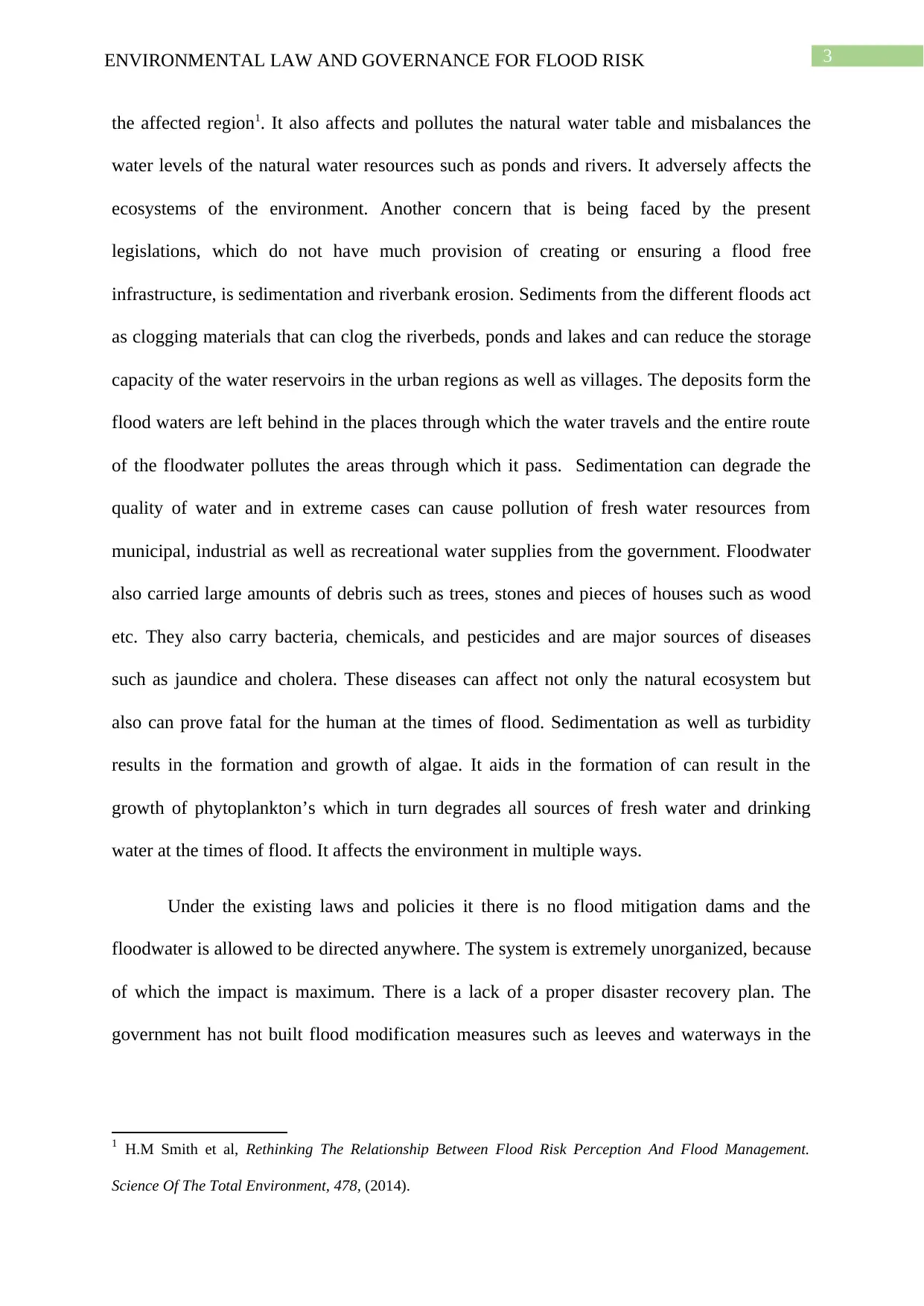
3ENVIRONMENTAL LAW AND GOVERNANCE FOR FLOOD RISK
the affected region1. It also affects and pollutes the natural water table and misbalances the
water levels of the natural water resources such as ponds and rivers. It adversely affects the
ecosystems of the environment. Another concern that is being faced by the present
legislations, which do not have much provision of creating or ensuring a flood free
infrastructure, is sedimentation and riverbank erosion. Sediments from the different floods act
as clogging materials that can clog the riverbeds, ponds and lakes and can reduce the storage
capacity of the water reservoirs in the urban regions as well as villages. The deposits form the
flood waters are left behind in the places through which the water travels and the entire route
of the floodwater pollutes the areas through which it pass. Sedimentation can degrade the
quality of water and in extreme cases can cause pollution of fresh water resources from
municipal, industrial as well as recreational water supplies from the government. Floodwater
also carried large amounts of debris such as trees, stones and pieces of houses such as wood
etc. They also carry bacteria, chemicals, and pesticides and are major sources of diseases
such as jaundice and cholera. These diseases can affect not only the natural ecosystem but
also can prove fatal for the human at the times of flood. Sedimentation as well as turbidity
results in the formation and growth of algae. It aids in the formation of can result in the
growth of phytoplankton’s which in turn degrades all sources of fresh water and drinking
water at the times of flood. It affects the environment in multiple ways.
Under the existing laws and policies it there is no flood mitigation dams and the
floodwater is allowed to be directed anywhere. The system is extremely unorganized, because
of which the impact is maximum. There is a lack of a proper disaster recovery plan. The
government has not built flood modification measures such as leeves and waterways in the
1 H.M Smith et al, Rethinking The Relationship Between Flood Risk Perception And Flood Management.
Science Of The Total Environment, 478, (2014).
the affected region1. It also affects and pollutes the natural water table and misbalances the
water levels of the natural water resources such as ponds and rivers. It adversely affects the
ecosystems of the environment. Another concern that is being faced by the present
legislations, which do not have much provision of creating or ensuring a flood free
infrastructure, is sedimentation and riverbank erosion. Sediments from the different floods act
as clogging materials that can clog the riverbeds, ponds and lakes and can reduce the storage
capacity of the water reservoirs in the urban regions as well as villages. The deposits form the
flood waters are left behind in the places through which the water travels and the entire route
of the floodwater pollutes the areas through which it pass. Sedimentation can degrade the
quality of water and in extreme cases can cause pollution of fresh water resources from
municipal, industrial as well as recreational water supplies from the government. Floodwater
also carried large amounts of debris such as trees, stones and pieces of houses such as wood
etc. They also carry bacteria, chemicals, and pesticides and are major sources of diseases
such as jaundice and cholera. These diseases can affect not only the natural ecosystem but
also can prove fatal for the human at the times of flood. Sedimentation as well as turbidity
results in the formation and growth of algae. It aids in the formation of can result in the
growth of phytoplankton’s which in turn degrades all sources of fresh water and drinking
water at the times of flood. It affects the environment in multiple ways.
Under the existing laws and policies it there is no flood mitigation dams and the
floodwater is allowed to be directed anywhere. The system is extremely unorganized, because
of which the impact is maximum. There is a lack of a proper disaster recovery plan. The
government has not built flood modification measures such as leeves and waterways in the
1 H.M Smith et al, Rethinking The Relationship Between Flood Risk Perception And Flood Management.
Science Of The Total Environment, 478, (2014).
Paraphrase This Document
Need a fresh take? Get an instant paraphrase of this document with our AI Paraphraser
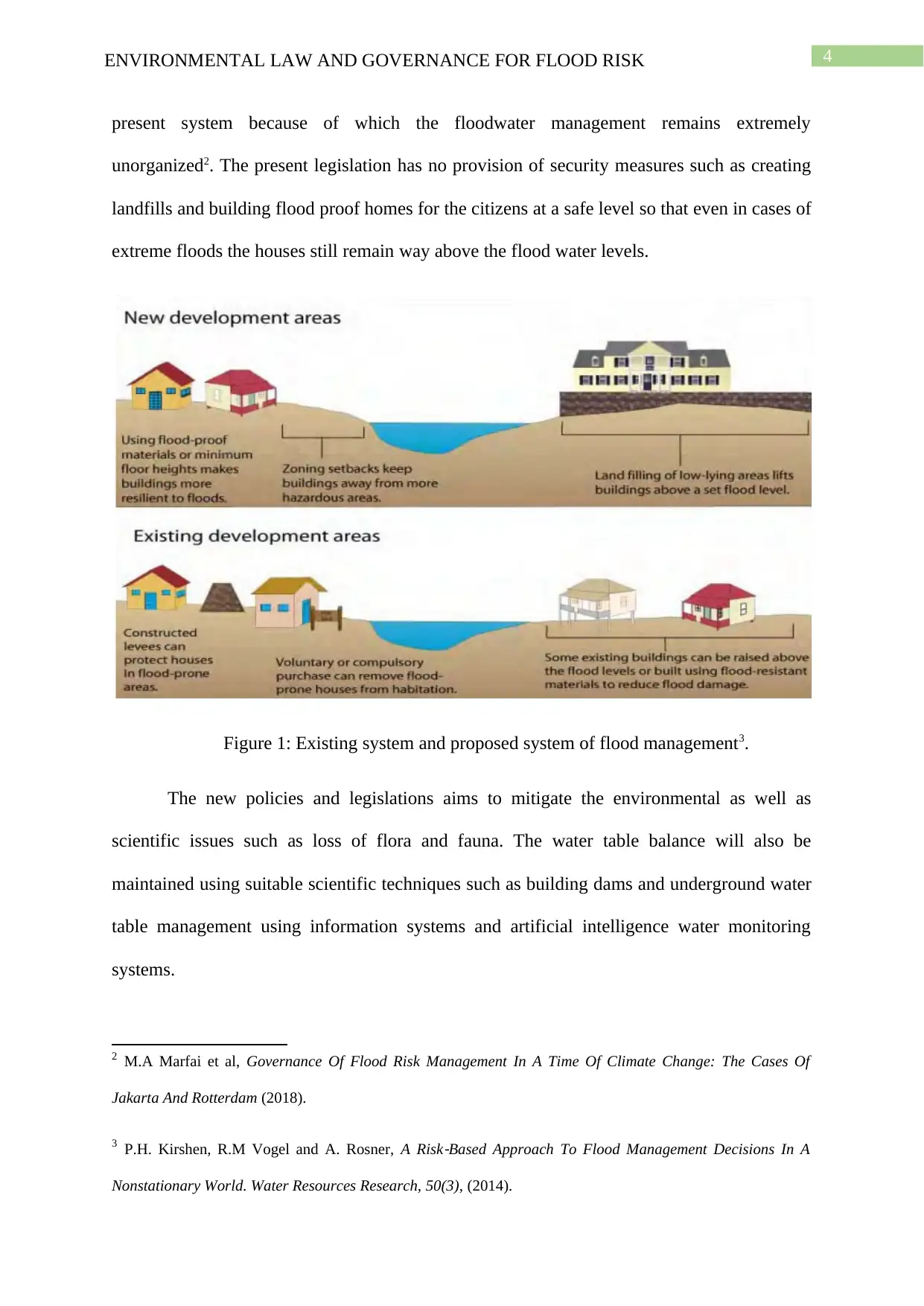
4ENVIRONMENTAL LAW AND GOVERNANCE FOR FLOOD RISK
present system because of which the floodwater management remains extremely
unorganized2. The present legislation has no provision of security measures such as creating
landfills and building flood proof homes for the citizens at a safe level so that even in cases of
extreme floods the houses still remain way above the flood water levels.
Figure 1: Existing system and proposed system of flood management3.
The new policies and legislations aims to mitigate the environmental as well as
scientific issues such as loss of flora and fauna. The water table balance will also be
maintained using suitable scientific techniques such as building dams and underground water
table management using information systems and artificial intelligence water monitoring
systems.
2 M.A Marfai et al, Governance Of Flood Risk Management In A Time Of Climate Change: The Cases Of
Jakarta And Rotterdam (2018).
3 P.H. Kirshen, R.M Vogel and A. Rosner, A Risk
‐Based Approach To Flood Management Decisions In A
Nonstationary World. Water Resources Research, 50(3), (2014).
present system because of which the floodwater management remains extremely
unorganized2. The present legislation has no provision of security measures such as creating
landfills and building flood proof homes for the citizens at a safe level so that even in cases of
extreme floods the houses still remain way above the flood water levels.
Figure 1: Existing system and proposed system of flood management3.
The new policies and legislations aims to mitigate the environmental as well as
scientific issues such as loss of flora and fauna. The water table balance will also be
maintained using suitable scientific techniques such as building dams and underground water
table management using information systems and artificial intelligence water monitoring
systems.
2 M.A Marfai et al, Governance Of Flood Risk Management In A Time Of Climate Change: The Cases Of
Jakarta And Rotterdam (2018).
3 P.H. Kirshen, R.M Vogel and A. Rosner, A Risk
‐Based Approach To Flood Management Decisions In A
Nonstationary World. Water Resources Research, 50(3), (2014).
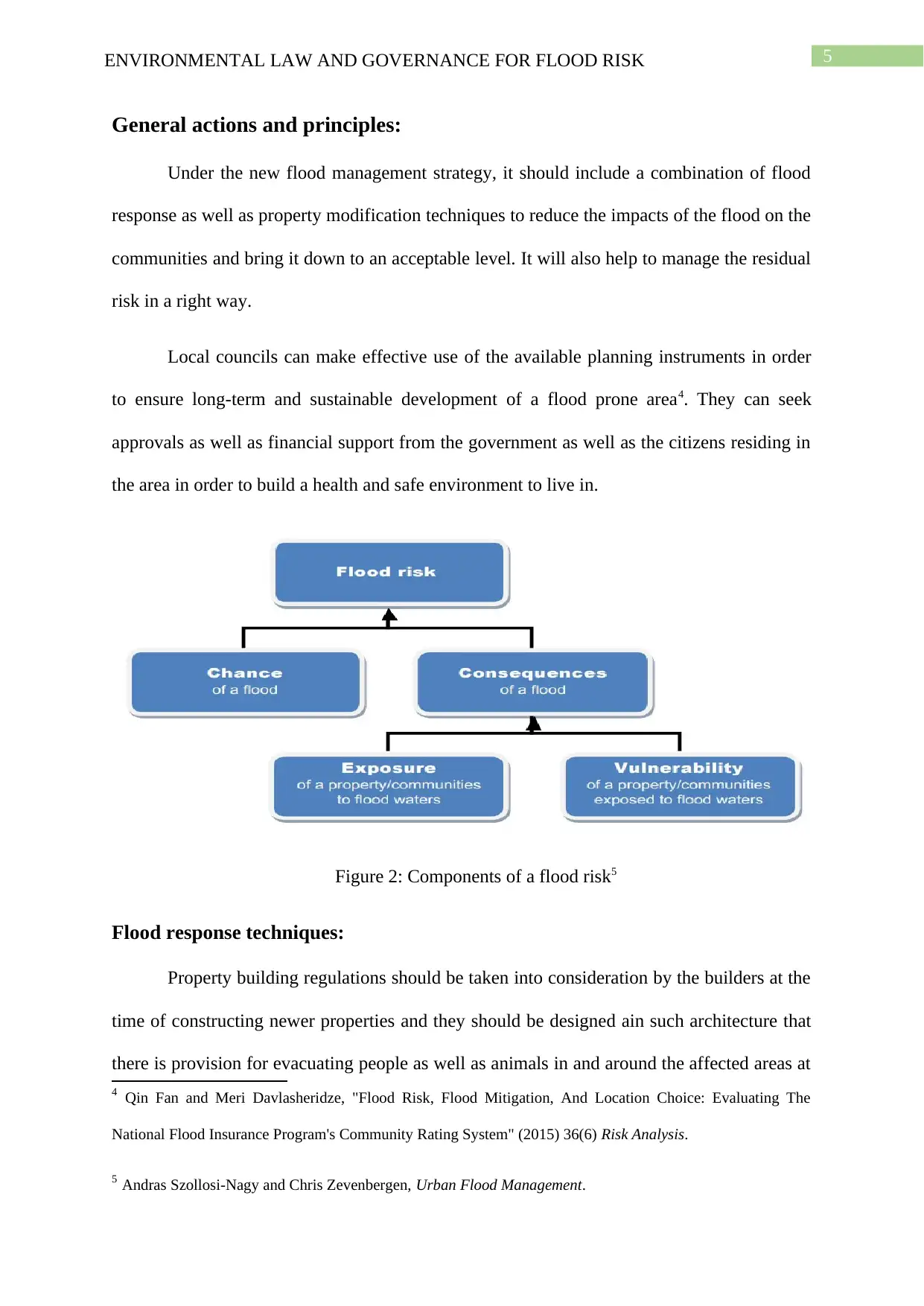
5ENVIRONMENTAL LAW AND GOVERNANCE FOR FLOOD RISK
General actions and principles:
Under the new flood management strategy, it should include a combination of flood
response as well as property modification techniques to reduce the impacts of the flood on the
communities and bring it down to an acceptable level. It will also help to manage the residual
risk in a right way.
Local councils can make effective use of the available planning instruments in order
to ensure long-term and sustainable development of a flood prone area4. They can seek
approvals as well as financial support from the government as well as the citizens residing in
the area in order to build a health and safe environment to live in.
Figure 2: Components of a flood risk5
Flood response techniques:
Property building regulations should be taken into consideration by the builders at the
time of constructing newer properties and they should be designed ain such architecture that
there is provision for evacuating people as well as animals in and around the affected areas at
4 Qin Fan and Meri Davlasheridze, "Flood Risk, Flood Mitigation, And Location Choice: Evaluating The
National Flood Insurance Program's Community Rating System" (2015) 36(6) Risk Analysis.
5 Andras Szollosi-Nagy and Chris Zevenbergen, Urban Flood Management.
General actions and principles:
Under the new flood management strategy, it should include a combination of flood
response as well as property modification techniques to reduce the impacts of the flood on the
communities and bring it down to an acceptable level. It will also help to manage the residual
risk in a right way.
Local councils can make effective use of the available planning instruments in order
to ensure long-term and sustainable development of a flood prone area4. They can seek
approvals as well as financial support from the government as well as the citizens residing in
the area in order to build a health and safe environment to live in.
Figure 2: Components of a flood risk5
Flood response techniques:
Property building regulations should be taken into consideration by the builders at the
time of constructing newer properties and they should be designed ain such architecture that
there is provision for evacuating people as well as animals in and around the affected areas at
4 Qin Fan and Meri Davlasheridze, "Flood Risk, Flood Mitigation, And Location Choice: Evaluating The
National Flood Insurance Program's Community Rating System" (2015) 36(6) Risk Analysis.
5 Andras Szollosi-Nagy and Chris Zevenbergen, Urban Flood Management.
⊘ This is a preview!⊘
Do you want full access?
Subscribe today to unlock all pages.

Trusted by 1+ million students worldwide
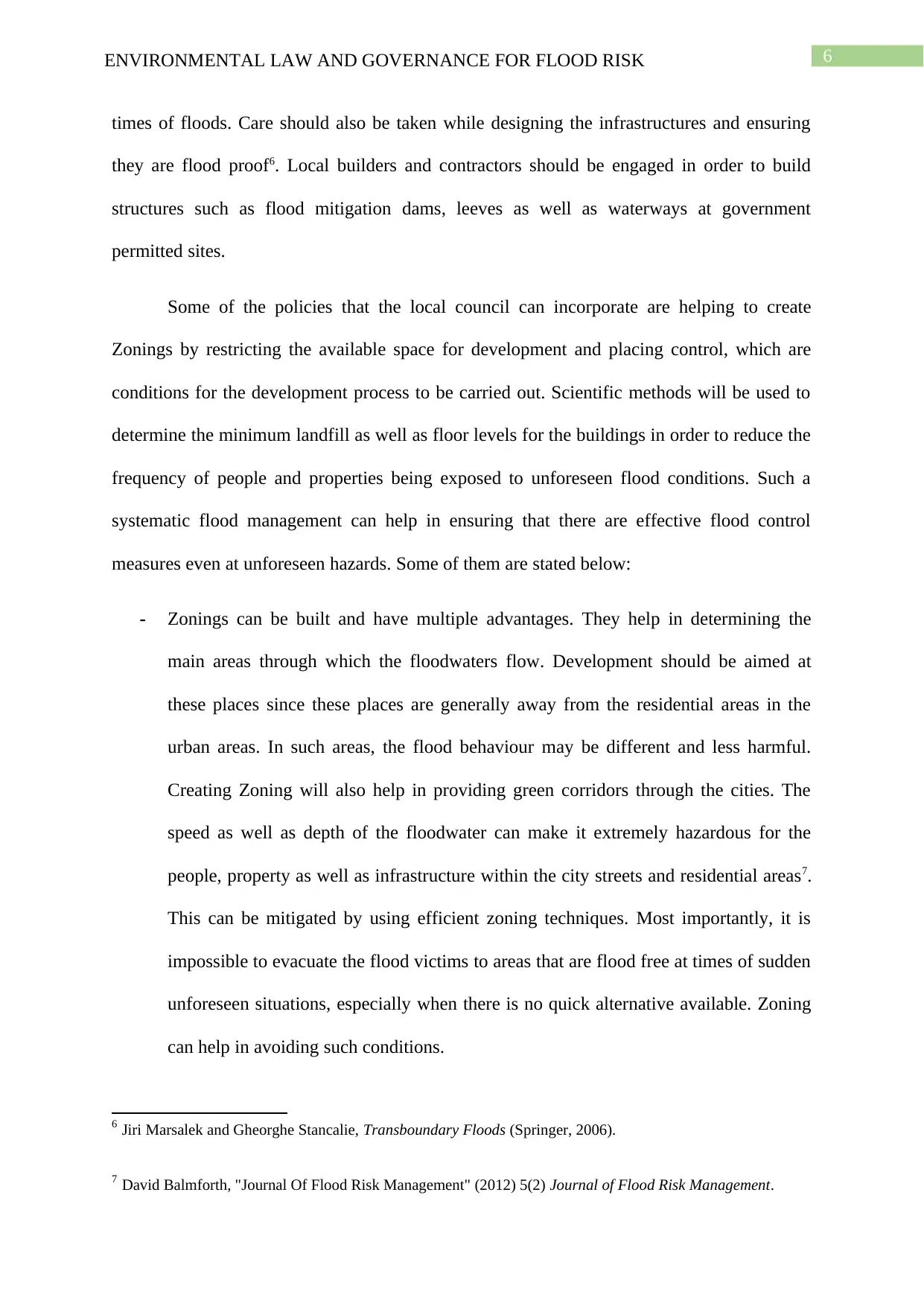
6ENVIRONMENTAL LAW AND GOVERNANCE FOR FLOOD RISK
times of floods. Care should also be taken while designing the infrastructures and ensuring
they are flood proof6. Local builders and contractors should be engaged in order to build
structures such as flood mitigation dams, leeves as well as waterways at government
permitted sites.
Some of the policies that the local council can incorporate are helping to create
Zonings by restricting the available space for development and placing control, which are
conditions for the development process to be carried out. Scientific methods will be used to
determine the minimum landfill as well as floor levels for the buildings in order to reduce the
frequency of people and properties being exposed to unforeseen flood conditions. Such a
systematic flood management can help in ensuring that there are effective flood control
measures even at unforeseen hazards. Some of them are stated below:
- Zonings can be built and have multiple advantages. They help in determining the
main areas through which the floodwaters flow. Development should be aimed at
these places since these places are generally away from the residential areas in the
urban areas. In such areas, the flood behaviour may be different and less harmful.
Creating Zoning will also help in providing green corridors through the cities. The
speed as well as depth of the floodwater can make it extremely hazardous for the
people, property as well as infrastructure within the city streets and residential areas7.
This can be mitigated by using efficient zoning techniques. Most importantly, it is
impossible to evacuate the flood victims to areas that are flood free at times of sudden
unforeseen situations, especially when there is no quick alternative available. Zoning
can help in avoiding such conditions.
6 Jiri Marsalek and Gheorghe Stancalie, Transboundary Floods (Springer, 2006).
7 David Balmforth, "Journal Of Flood Risk Management" (2012) 5(2) Journal of Flood Risk Management.
times of floods. Care should also be taken while designing the infrastructures and ensuring
they are flood proof6. Local builders and contractors should be engaged in order to build
structures such as flood mitigation dams, leeves as well as waterways at government
permitted sites.
Some of the policies that the local council can incorporate are helping to create
Zonings by restricting the available space for development and placing control, which are
conditions for the development process to be carried out. Scientific methods will be used to
determine the minimum landfill as well as floor levels for the buildings in order to reduce the
frequency of people and properties being exposed to unforeseen flood conditions. Such a
systematic flood management can help in ensuring that there are effective flood control
measures even at unforeseen hazards. Some of them are stated below:
- Zonings can be built and have multiple advantages. They help in determining the
main areas through which the floodwaters flow. Development should be aimed at
these places since these places are generally away from the residential areas in the
urban areas. In such areas, the flood behaviour may be different and less harmful.
Creating Zoning will also help in providing green corridors through the cities. The
speed as well as depth of the floodwater can make it extremely hazardous for the
people, property as well as infrastructure within the city streets and residential areas7.
This can be mitigated by using efficient zoning techniques. Most importantly, it is
impossible to evacuate the flood victims to areas that are flood free at times of sudden
unforeseen situations, especially when there is no quick alternative available. Zoning
can help in avoiding such conditions.
6 Jiri Marsalek and Gheorghe Stancalie, Transboundary Floods (Springer, 2006).
7 David Balmforth, "Journal Of Flood Risk Management" (2012) 5(2) Journal of Flood Risk Management.
Paraphrase This Document
Need a fresh take? Get an instant paraphrase of this document with our AI Paraphraser
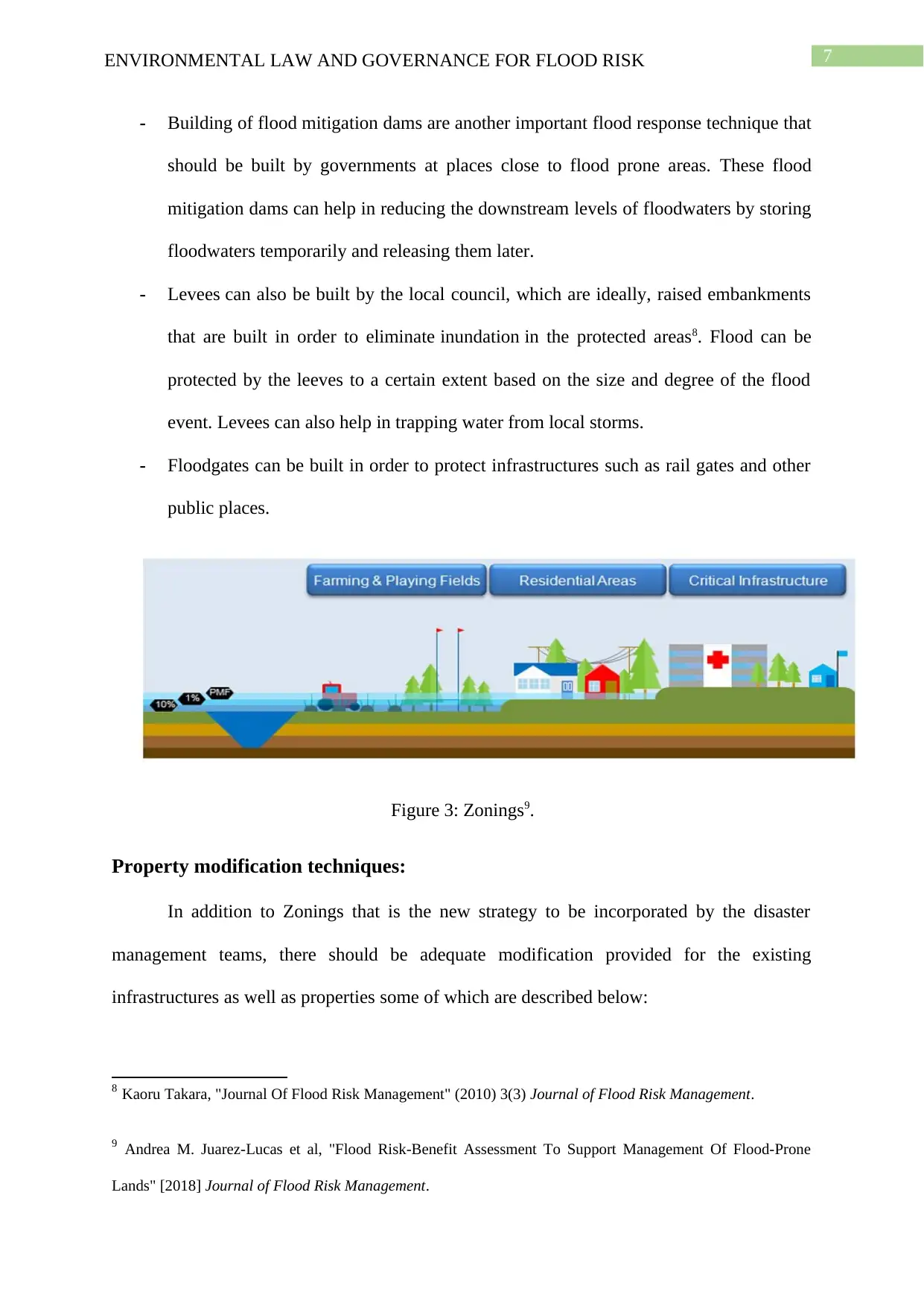
7ENVIRONMENTAL LAW AND GOVERNANCE FOR FLOOD RISK
- Building of flood mitigation dams are another important flood response technique that
should be built by governments at places close to flood prone areas. These flood
mitigation dams can help in reducing the downstream levels of floodwaters by storing
floodwaters temporarily and releasing them later.
- Levees can also be built by the local council, which are ideally, raised embankments
that are built in order to eliminate inundation in the protected areas8. Flood can be
protected by the leeves to a certain extent based on the size and degree of the flood
event. Levees can also help in trapping water from local storms.
- Floodgates can be built in order to protect infrastructures such as rail gates and other
public places.
Figure 3: Zonings9.
Property modification techniques:
In addition to Zonings that is the new strategy to be incorporated by the disaster
management teams, there should be adequate modification provided for the existing
infrastructures as well as properties some of which are described below:
8 Kaoru Takara, "Journal Of Flood Risk Management" (2010) 3(3) Journal of Flood Risk Management.
9 Andrea M. Juarez-Lucas et al, "Flood Risk-Benefit Assessment To Support Management Of Flood-Prone
Lands" [2018] Journal of Flood Risk Management.
- Building of flood mitigation dams are another important flood response technique that
should be built by governments at places close to flood prone areas. These flood
mitigation dams can help in reducing the downstream levels of floodwaters by storing
floodwaters temporarily and releasing them later.
- Levees can also be built by the local council, which are ideally, raised embankments
that are built in order to eliminate inundation in the protected areas8. Flood can be
protected by the leeves to a certain extent based on the size and degree of the flood
event. Levees can also help in trapping water from local storms.
- Floodgates can be built in order to protect infrastructures such as rail gates and other
public places.
Figure 3: Zonings9.
Property modification techniques:
In addition to Zonings that is the new strategy to be incorporated by the disaster
management teams, there should be adequate modification provided for the existing
infrastructures as well as properties some of which are described below:
8 Kaoru Takara, "Journal Of Flood Risk Management" (2010) 3(3) Journal of Flood Risk Management.
9 Andrea M. Juarez-Lucas et al, "Flood Risk-Benefit Assessment To Support Management Of Flood-Prone
Lands" [2018] Journal of Flood Risk Management.
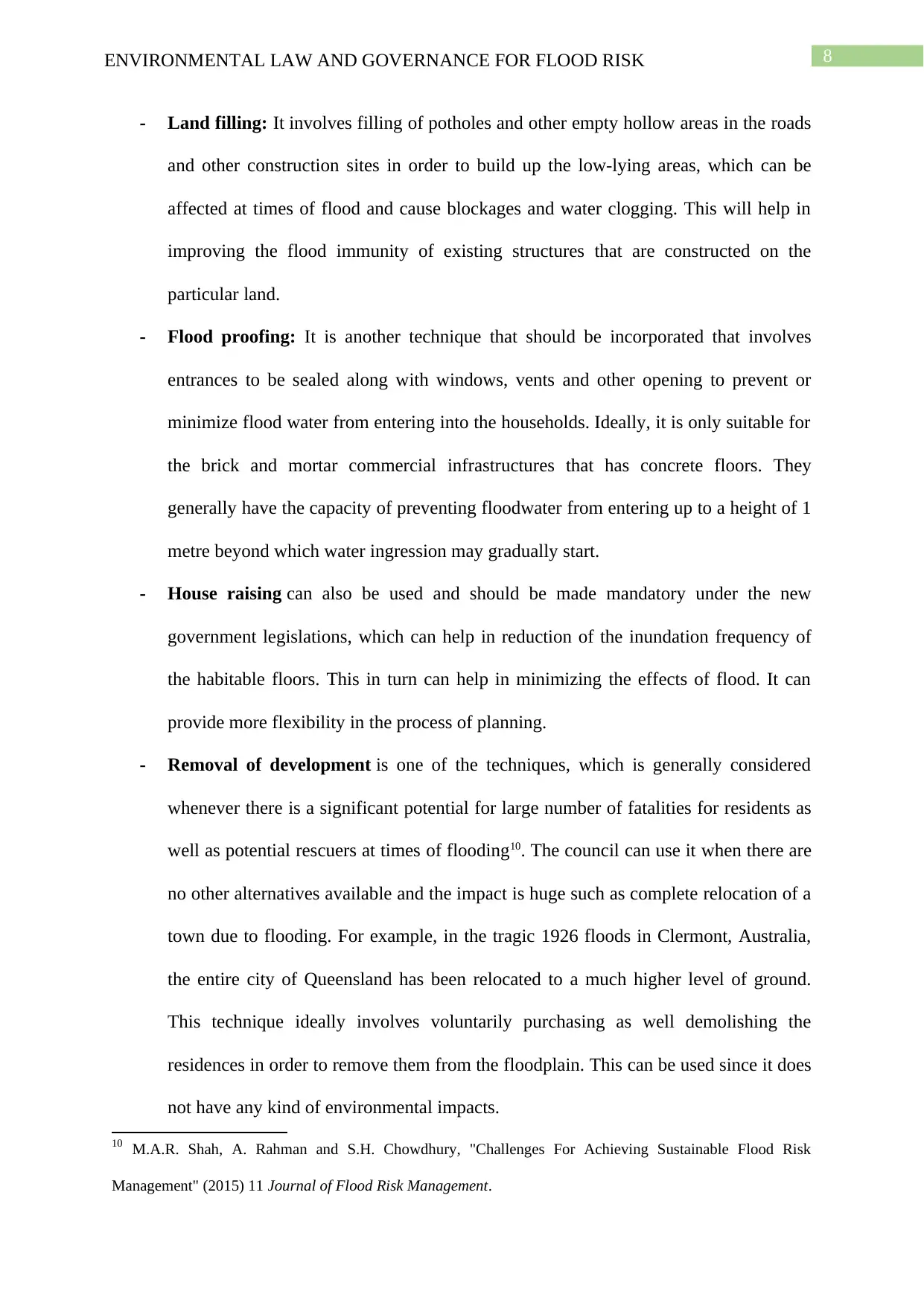
8ENVIRONMENTAL LAW AND GOVERNANCE FOR FLOOD RISK
- Land filling: It involves filling of potholes and other empty hollow areas in the roads
and other construction sites in order to build up the low-lying areas, which can be
affected at times of flood and cause blockages and water clogging. This will help in
improving the flood immunity of existing structures that are constructed on the
particular land.
- Flood proofing: It is another technique that should be incorporated that involves
entrances to be sealed along with windows, vents and other opening to prevent or
minimize flood water from entering into the households. Ideally, it is only suitable for
the brick and mortar commercial infrastructures that has concrete floors. They
generally have the capacity of preventing floodwater from entering up to a height of 1
metre beyond which water ingression may gradually start.
- House raising can also be used and should be made mandatory under the new
government legislations, which can help in reduction of the inundation frequency of
the habitable floors. This in turn can help in minimizing the effects of flood. It can
provide more flexibility in the process of planning.
- Removal of development is one of the techniques, which is generally considered
whenever there is a significant potential for large number of fatalities for residents as
well as potential rescuers at times of flooding10. The council can use it when there are
no other alternatives available and the impact is huge such as complete relocation of a
town due to flooding. For example, in the tragic 1926 floods in Clermont, Australia,
the entire city of Queensland has been relocated to a much higher level of ground.
This technique ideally involves voluntarily purchasing as well demolishing the
residences in order to remove them from the floodplain. This can be used since it does
not have any kind of environmental impacts.
10 M.A.R. Shah, A. Rahman and S.H. Chowdhury, "Challenges For Achieving Sustainable Flood Risk
Management" (2015) 11 Journal of Flood Risk Management.
- Land filling: It involves filling of potholes and other empty hollow areas in the roads
and other construction sites in order to build up the low-lying areas, which can be
affected at times of flood and cause blockages and water clogging. This will help in
improving the flood immunity of existing structures that are constructed on the
particular land.
- Flood proofing: It is another technique that should be incorporated that involves
entrances to be sealed along with windows, vents and other opening to prevent or
minimize flood water from entering into the households. Ideally, it is only suitable for
the brick and mortar commercial infrastructures that has concrete floors. They
generally have the capacity of preventing floodwater from entering up to a height of 1
metre beyond which water ingression may gradually start.
- House raising can also be used and should be made mandatory under the new
government legislations, which can help in reduction of the inundation frequency of
the habitable floors. This in turn can help in minimizing the effects of flood. It can
provide more flexibility in the process of planning.
- Removal of development is one of the techniques, which is generally considered
whenever there is a significant potential for large number of fatalities for residents as
well as potential rescuers at times of flooding10. The council can use it when there are
no other alternatives available and the impact is huge such as complete relocation of a
town due to flooding. For example, in the tragic 1926 floods in Clermont, Australia,
the entire city of Queensland has been relocated to a much higher level of ground.
This technique ideally involves voluntarily purchasing as well demolishing the
residences in order to remove them from the floodplain. This can be used since it does
not have any kind of environmental impacts.
10 M.A.R. Shah, A. Rahman and S.H. Chowdhury, "Challenges For Achieving Sustainable Flood Risk
Management" (2015) 11 Journal of Flood Risk Management.
⊘ This is a preview!⊘
Do you want full access?
Subscribe today to unlock all pages.

Trusted by 1+ million students worldwide
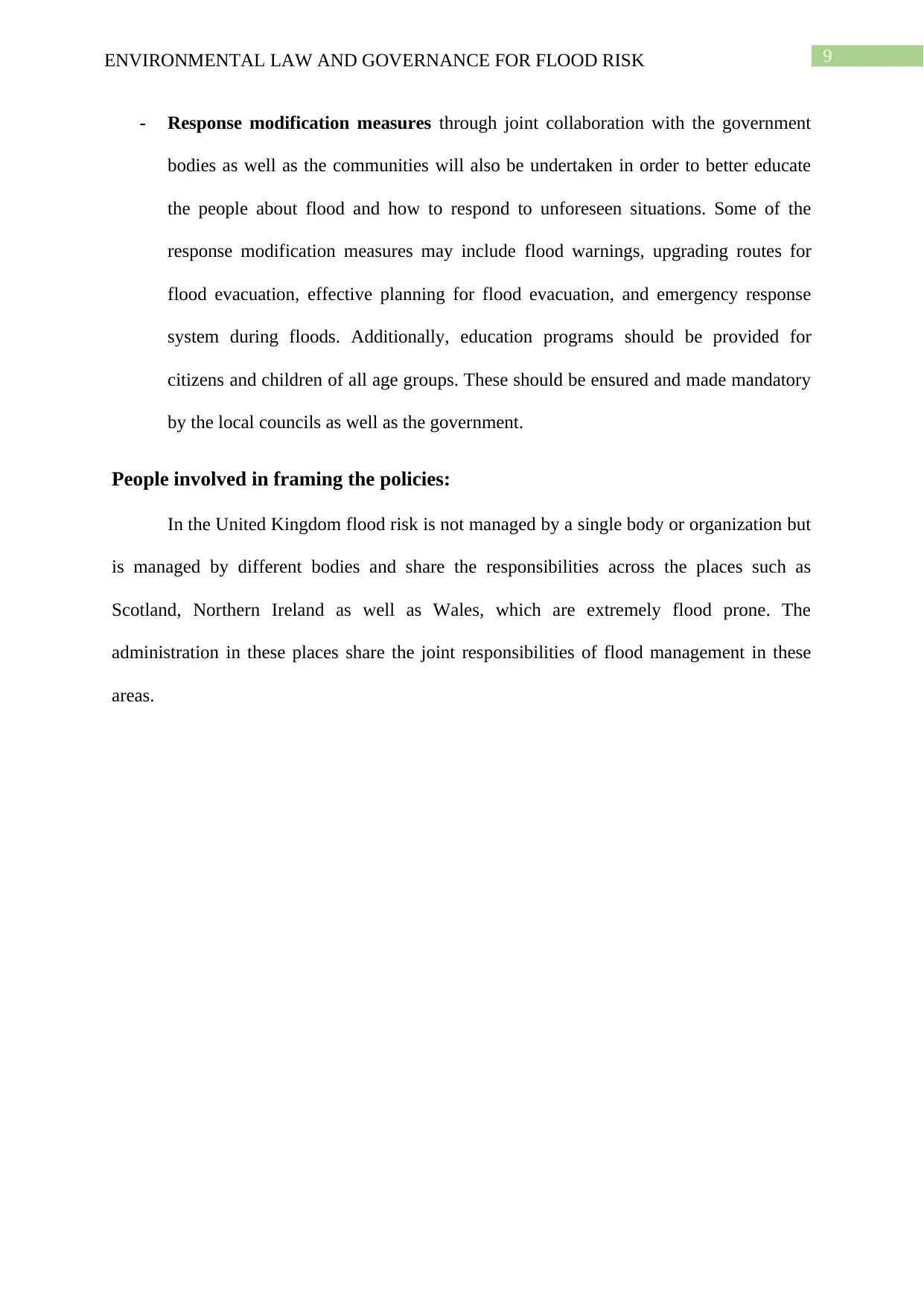
9ENVIRONMENTAL LAW AND GOVERNANCE FOR FLOOD RISK
- Response modification measures through joint collaboration with the government
bodies as well as the communities will also be undertaken in order to better educate
the people about flood and how to respond to unforeseen situations. Some of the
response modification measures may include flood warnings, upgrading routes for
flood evacuation, effective planning for flood evacuation, and emergency response
system during floods. Additionally, education programs should be provided for
citizens and children of all age groups. These should be ensured and made mandatory
by the local councils as well as the government.
People involved in framing the policies:
In the United Kingdom flood risk is not managed by a single body or organization but
is managed by different bodies and share the responsibilities across the places such as
Scotland, Northern Ireland as well as Wales, which are extremely flood prone. The
administration in these places share the joint responsibilities of flood management in these
areas.
- Response modification measures through joint collaboration with the government
bodies as well as the communities will also be undertaken in order to better educate
the people about flood and how to respond to unforeseen situations. Some of the
response modification measures may include flood warnings, upgrading routes for
flood evacuation, effective planning for flood evacuation, and emergency response
system during floods. Additionally, education programs should be provided for
citizens and children of all age groups. These should be ensured and made mandatory
by the local councils as well as the government.
People involved in framing the policies:
In the United Kingdom flood risk is not managed by a single body or organization but
is managed by different bodies and share the responsibilities across the places such as
Scotland, Northern Ireland as well as Wales, which are extremely flood prone. The
administration in these places share the joint responsibilities of flood management in these
areas.
Paraphrase This Document
Need a fresh take? Get an instant paraphrase of this document with our AI Paraphraser
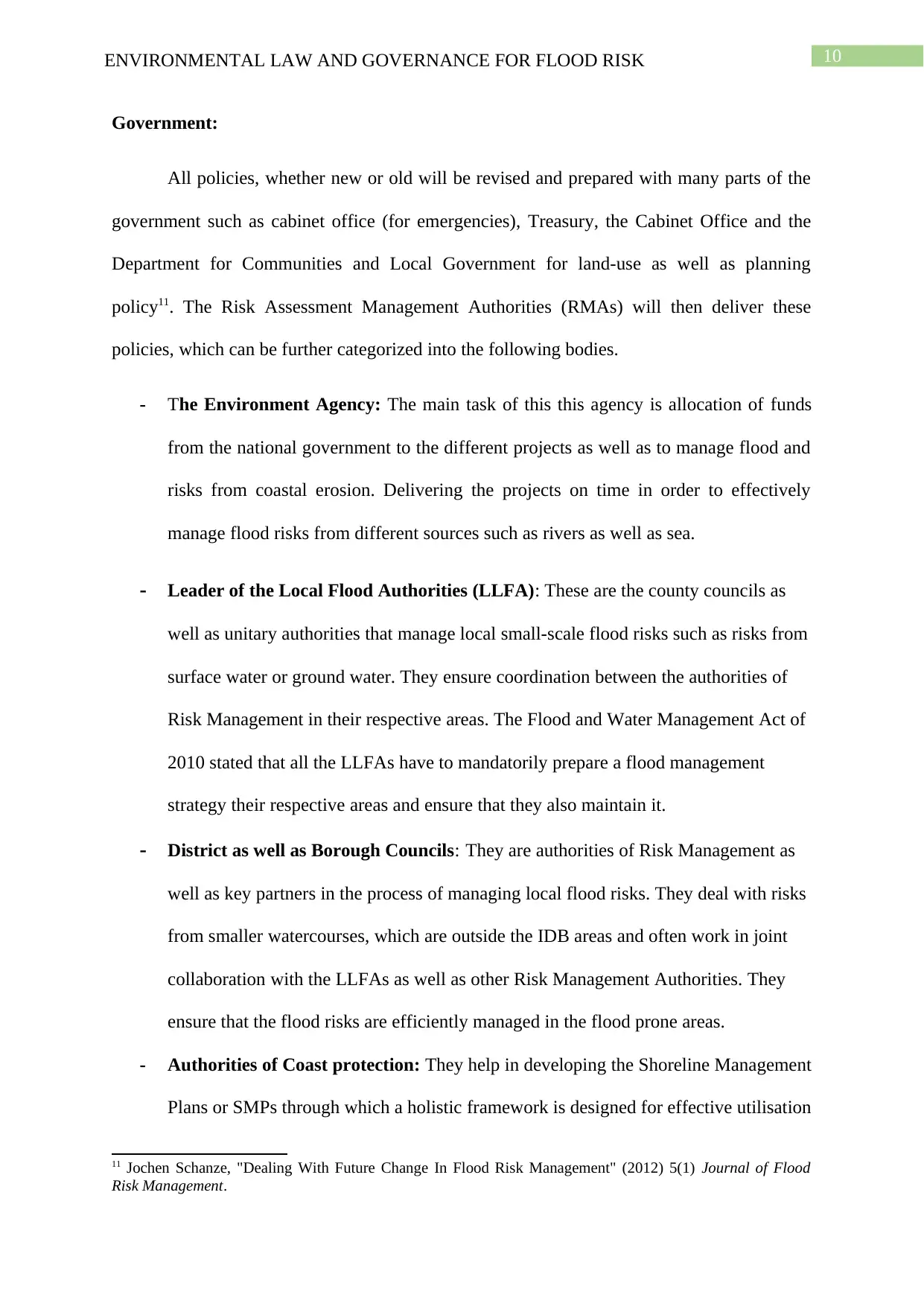
10ENVIRONMENTAL LAW AND GOVERNANCE FOR FLOOD RISK
Government:
All policies, whether new or old will be revised and prepared with many parts of the
government such as cabinet office (for emergencies), Treasury, the Cabinet Office and the
Department for Communities and Local Government for land-use as well as planning
policy11. The Risk Assessment Management Authorities (RMAs) will then deliver these
policies, which can be further categorized into the following bodies.
- The Environment Agency: The main task of this this agency is allocation of funds
from the national government to the different projects as well as to manage flood and
risks from coastal erosion. Delivering the projects on time in order to effectively
manage flood risks from different sources such as rivers as well as sea.
- Leader of the Local Flood Authorities (LLFA): These are the county councils as
well as unitary authorities that manage local small-scale flood risks such as risks from
surface water or ground water. They ensure coordination between the authorities of
Risk Management in their respective areas. The Flood and Water Management Act of
2010 stated that all the LLFAs have to mandatorily prepare a flood management
strategy their respective areas and ensure that they also maintain it.
- District as well as Borough Councils: They are authorities of Risk Management as
well as key partners in the process of managing local flood risks. They deal with risks
from smaller watercourses, which are outside the IDB areas and often work in joint
collaboration with the LLFAs as well as other Risk Management Authorities. They
ensure that the flood risks are efficiently managed in the flood prone areas.
- Authorities of Coast protection: They help in developing the Shoreline Management
Plans or SMPs through which a holistic framework is designed for effective utilisation
11 Jochen Schanze, "Dealing With Future Change In Flood Risk Management" (2012) 5(1) Journal of Flood
Risk Management.
Government:
All policies, whether new or old will be revised and prepared with many parts of the
government such as cabinet office (for emergencies), Treasury, the Cabinet Office and the
Department for Communities and Local Government for land-use as well as planning
policy11. The Risk Assessment Management Authorities (RMAs) will then deliver these
policies, which can be further categorized into the following bodies.
- The Environment Agency: The main task of this this agency is allocation of funds
from the national government to the different projects as well as to manage flood and
risks from coastal erosion. Delivering the projects on time in order to effectively
manage flood risks from different sources such as rivers as well as sea.
- Leader of the Local Flood Authorities (LLFA): These are the county councils as
well as unitary authorities that manage local small-scale flood risks such as risks from
surface water or ground water. They ensure coordination between the authorities of
Risk Management in their respective areas. The Flood and Water Management Act of
2010 stated that all the LLFAs have to mandatorily prepare a flood management
strategy their respective areas and ensure that they also maintain it.
- District as well as Borough Councils: They are authorities of Risk Management as
well as key partners in the process of managing local flood risks. They deal with risks
from smaller watercourses, which are outside the IDB areas and often work in joint
collaboration with the LLFAs as well as other Risk Management Authorities. They
ensure that the flood risks are efficiently managed in the flood prone areas.
- Authorities of Coast protection: They help in developing the Shoreline Management
Plans or SMPs through which a holistic framework is designed for effective utilisation
11 Jochen Schanze, "Dealing With Future Change In Flood Risk Management" (2012) 5(1) Journal of Flood
Risk Management.
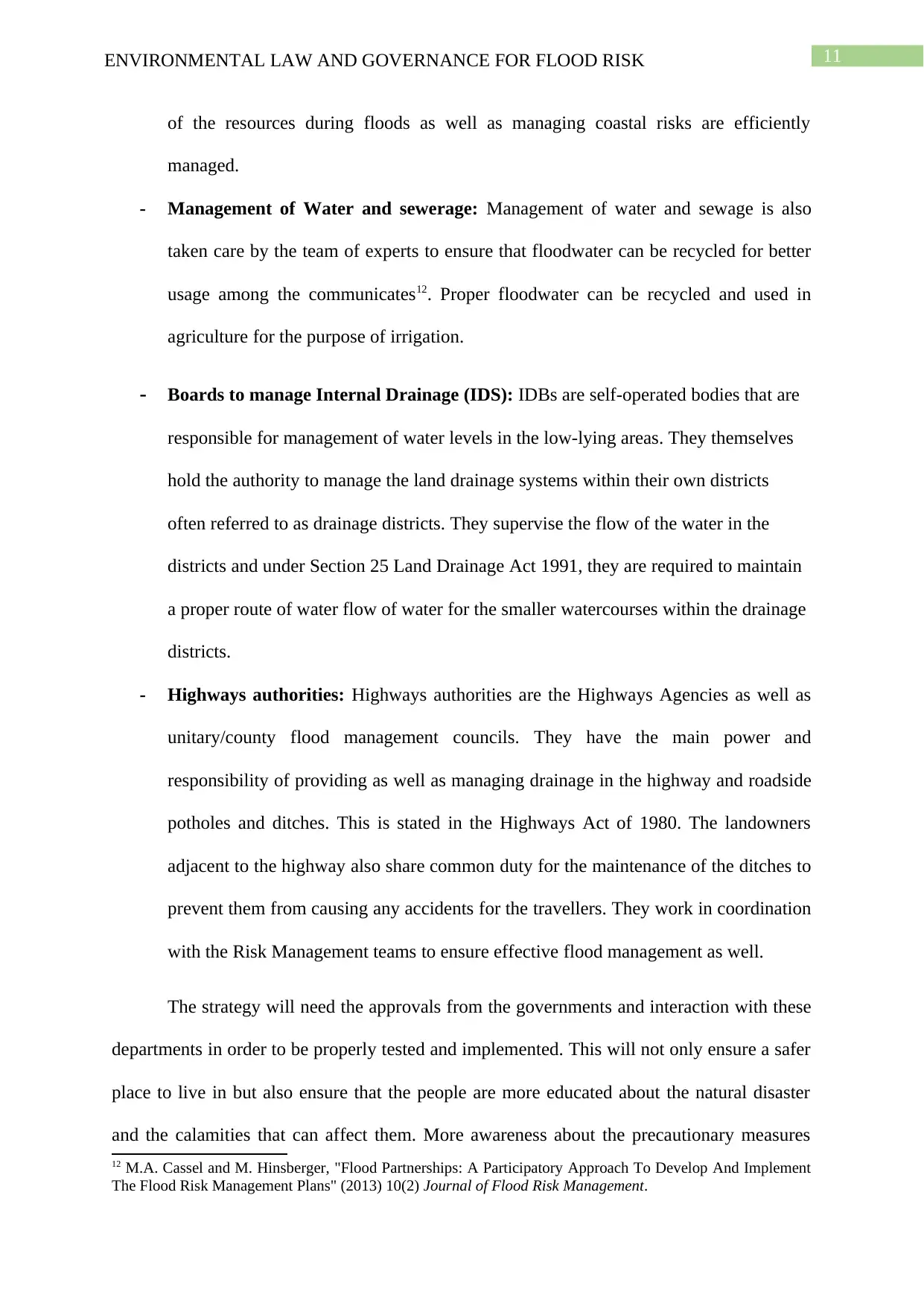
11ENVIRONMENTAL LAW AND GOVERNANCE FOR FLOOD RISK
of the resources during floods as well as managing coastal risks are efficiently
managed.
- Management of Water and sewerage: Management of water and sewage is also
taken care by the team of experts to ensure that floodwater can be recycled for better
usage among the communicates12. Proper floodwater can be recycled and used in
agriculture for the purpose of irrigation.
- Boards to manage Internal Drainage (IDS): IDBs are self-operated bodies that are
responsible for management of water levels in the low-lying areas. They themselves
hold the authority to manage the land drainage systems within their own districts
often referred to as drainage districts. They supervise the flow of the water in the
districts and under Section 25 Land Drainage Act 1991, they are required to maintain
a proper route of water flow of water for the smaller watercourses within the drainage
districts.
- Highways authorities: Highways authorities are the Highways Agencies as well as
unitary/county flood management councils. They have the main power and
responsibility of providing as well as managing drainage in the highway and roadside
potholes and ditches. This is stated in the Highways Act of 1980. The landowners
adjacent to the highway also share common duty for the maintenance of the ditches to
prevent them from causing any accidents for the travellers. They work in coordination
with the Risk Management teams to ensure effective flood management as well.
The strategy will need the approvals from the governments and interaction with these
departments in order to be properly tested and implemented. This will not only ensure a safer
place to live in but also ensure that the people are more educated about the natural disaster
and the calamities that can affect them. More awareness about the precautionary measures
12 M.A. Cassel and M. Hinsberger, "Flood Partnerships: A Participatory Approach To Develop And Implement
The Flood Risk Management Plans" (2013) 10(2) Journal of Flood Risk Management.
of the resources during floods as well as managing coastal risks are efficiently
managed.
- Management of Water and sewerage: Management of water and sewage is also
taken care by the team of experts to ensure that floodwater can be recycled for better
usage among the communicates12. Proper floodwater can be recycled and used in
agriculture for the purpose of irrigation.
- Boards to manage Internal Drainage (IDS): IDBs are self-operated bodies that are
responsible for management of water levels in the low-lying areas. They themselves
hold the authority to manage the land drainage systems within their own districts
often referred to as drainage districts. They supervise the flow of the water in the
districts and under Section 25 Land Drainage Act 1991, they are required to maintain
a proper route of water flow of water for the smaller watercourses within the drainage
districts.
- Highways authorities: Highways authorities are the Highways Agencies as well as
unitary/county flood management councils. They have the main power and
responsibility of providing as well as managing drainage in the highway and roadside
potholes and ditches. This is stated in the Highways Act of 1980. The landowners
adjacent to the highway also share common duty for the maintenance of the ditches to
prevent them from causing any accidents for the travellers. They work in coordination
with the Risk Management teams to ensure effective flood management as well.
The strategy will need the approvals from the governments and interaction with these
departments in order to be properly tested and implemented. This will not only ensure a safer
place to live in but also ensure that the people are more educated about the natural disaster
and the calamities that can affect them. More awareness about the precautionary measures
12 M.A. Cassel and M. Hinsberger, "Flood Partnerships: A Participatory Approach To Develop And Implement
The Flood Risk Management Plans" (2013) 10(2) Journal of Flood Risk Management.
⊘ This is a preview!⊘
Do you want full access?
Subscribe today to unlock all pages.

Trusted by 1+ million students worldwide
1 out of 16
Related Documents
Your All-in-One AI-Powered Toolkit for Academic Success.
+13062052269
info@desklib.com
Available 24*7 on WhatsApp / Email
![[object Object]](/_next/static/media/star-bottom.7253800d.svg)
Unlock your academic potential
Copyright © 2020–2025 A2Z Services. All Rights Reserved. Developed and managed by ZUCOL.





